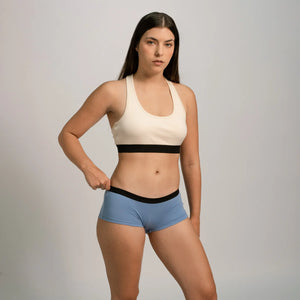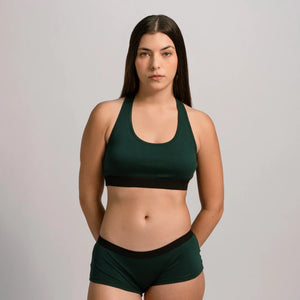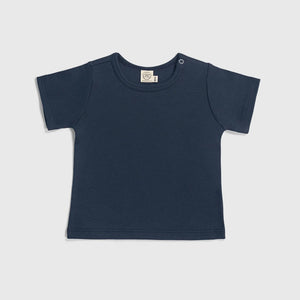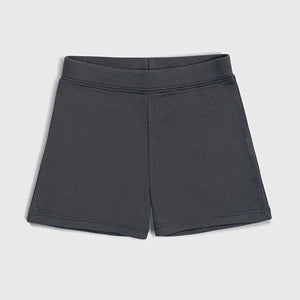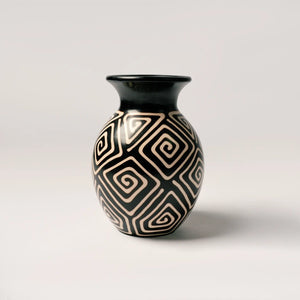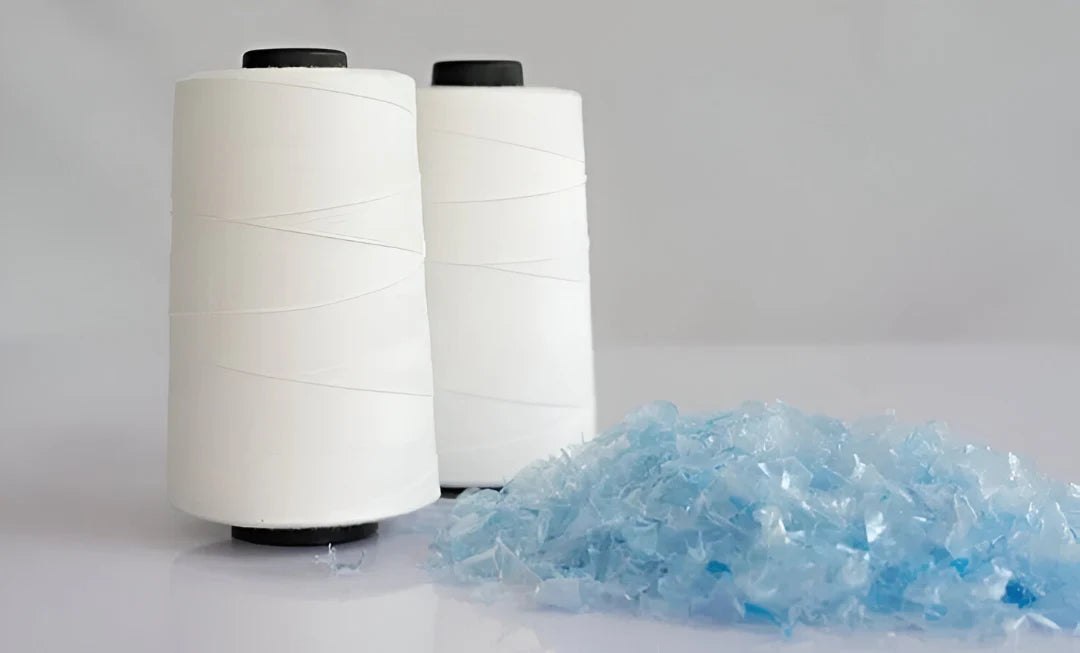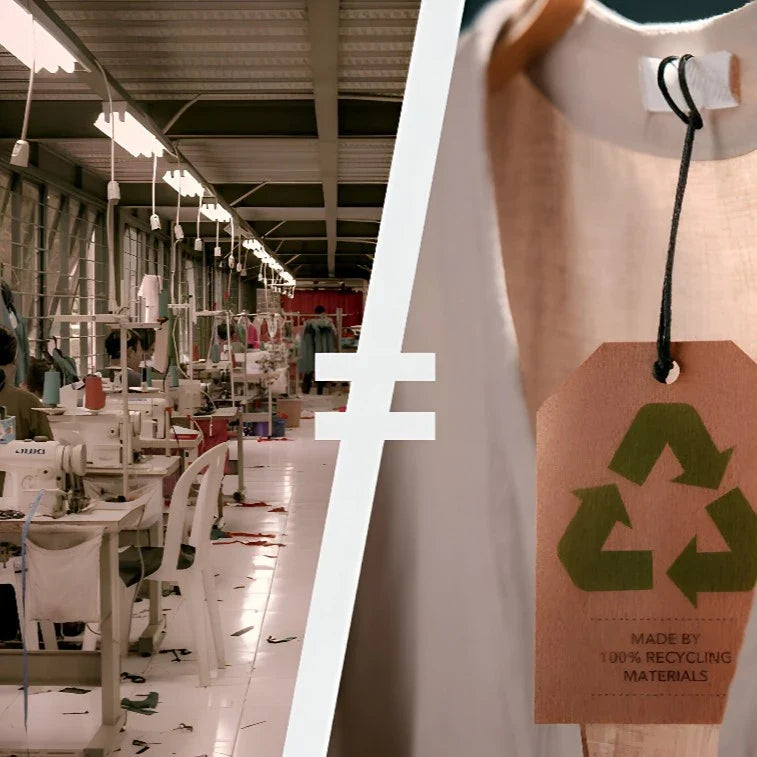Organic Cotton vs Conventional Cotton:
What's the Real Difference?
.
AYA | JULY 4, 2025
READING TIME: 6 minutes
By Jordy Munarriz
AYA | JULY 4, 2025
READING TIME: 6 minutes
By Jordy Munarriz
Cotton is the most commonly used natural fiber in the world, found in everything from everyday basics to high-end garments. But behind its soft, familiar texture lies a much harsher reality—one marked by environmental strain and health concerns. [1]
A Life Cycle Assessment by Textile Exchange highlights just how much more sustainable organic cotton can be. Compared to conventional cotton, it uses 91% less blue water, produces 46% fewer greenhouse gas emissions, and requires 62% less primary energy. [1] Beyond resource use, conventional cotton has long been one of the most chemically intensive crops in agriculture—responsible for around 4% of all pesticides used globally. This heavy reliance on chemicals not only strains ecosystems but also poses serious risks to the health of farmers, workers, and surrounding communities. [2]
As the fashion industry pushes toward more responsible production models, organic cotton is gaining attention as a meaningful alternative. In this article, we’ll dive into the core differences in how it’s grown, its environmental footprint, chemical exposure, impact on farmers and workers, and its role in a more sustainable future.
Pesticides and Chemical Exposure
One of the most concerning aspects of conventional cotton production lies in its heavy reliance on synthetic pesticides. Globally, agriculture consumes over 2.5 million tonnes of pesticides annually—and cotton stands out as one of the most chemically intensive crops by hectare [2]. In fact, conventional cotton alone is responsible for about 16% of all insecticide use worldwide [3], more than any other single crop, with close to 1 kilogram of hazardous pesticides applied per hectare.
This toxic burden has profound consequences—not only for ecosystems but for the health of those working in the fields. Multiple pesticides used in conventional cotton are classified as hazardous by the World Health Organization (WHO) and the United Nations [2]. A study conducted in Tanzania found that 48% of conventional cotton farmers reported symptoms of acute pesticide poisoning in the past year [4]. Common symptoms included persistent coughing, skin and throat irritation, muscle weakness, and even difficulty speaking. Alarmingly, most incidents were linked to just four active ingredients: profenofos, lambda-cyhalothrin, chlorpyrifos, and cypermethrin [4].
By contrast, organic cotton systems paint a markedly different picture. Research in Burkina Faso confirms that organic farmers rely exclusively on natural insecticides, avoiding synthetic chemicals altogether [5]. These producers report significantly fewer health issues, even when protective equipment is limited. Organic cotton farming reduces chemical toxicity by up to 90% compared to conventional systems [2,4]—offering safer working conditions and a lower-risk environment for surrounding communities.

Pesticide irrigation in conventional cotton fields.
Water Use and Soil Health
On average, it takes around 2,700 liters of water to produce a single conventional cotton T-shirt [6,7]. That’s equivalent to nearly three years’ worth of drinking water for one person. But the issue goes beyond just quantity. The quality of water is also affected. In conventional systems, the widespread use of chemical fertilizers and pesticides creates a “grey water” footprint—the volume of water required to dilute pollutants to safe levels [8]. A study conducted in India found that organic cotton reduced this grey water footprint by over 75% compared to conventional cotton [8]. The key difference? Organic farming prioritizes rain-fed irrigation (also known as green water [8]), significantly lowering the strain on freshwater reserves.
Conventional cotton’s reliance on monocultures, synthetic fertilizers, and intensive soil disturbance leads to soil degradation, loss of organic matter, and biodiversity decline [9,10]. Over time, this erodes soil fertility and increases vulnerability to drought.
In contrast, organic systems work with the land. By using compost, green manure, and crop rotation, organic cotton farming not only improves soil structure and nutrient content but also enhances carbon sequestration and water retention capacity. These regenerative methods reduce dependency on external inputs and help buffer crops against climate stress [11].

Technological irrigation in organic cotton fields, which reduces water use.
Worker Welfare and Fair Trade
Globally, cotton sustains the livelihoods of over 100 million households, primarily in developing countries where smallholder farming is the norm [12]. In these rural economies, cotton is more than just a fiber—it's a cornerstone of food security, education access, and long-term community development.
Yet, despite its central role, cotton farming is marked by deep socioeconomic challenges. Field studies in Mali and Burkina Faso show that many cotton farmers remain trapped in cycles of poverty, burdened by high input costs, limited access to financial services, and volatile commodity prices [13].
That’s where certified organic and Fair Trade cotton systems offer a meaningful alternative. Certification schemes such as GOTS (Global Organic Textile Standard) and Fairtrade do more than verify environmental claims—they embed social protection standards into every level of the supply chain. These include mandates for safe working conditions, fair wages, and contracts that promote stability and transparency [1,14].
Studies by the International Labour Organization [15] have shown that reducing pesticide exposure not only improves the health of farm workers but also strengthens household resilience and educational outcomes in rural areas. Children, often at risk of entering hazardous agricultural labor, are less likely to work when farms operate under safer and more equitable frameworks.
However, systemic barriers persist. Agricultural subsidies in high-income countries, especially for cotton, continue to distort global markets. These subsidies artificially lower prices, making it harder for smallholder farmers in the Global South to compete and earn a living wage [16]. This imbalance perpetuates inequality across the supply chain and undermines efforts toward ethical sourcing.

Farmers working in organic cotton fields.
Changing Demographics and Preferences
The pandemic also highlighted shifting demographics in the fashion market. Younger consumers, particularly Gen Z and Millennials, became increasingly influential in shaping purchasing trends. Research from the Institute for Sustainable Fashion indicates that younger generations are more likely to support sustainable brands, with 83% of Millennials stating they prefer to buy from companies that share their values [7,8].
Moreover, with the rise of remote work, many consumers reported a preference for comfort over style. A study published in the Journal of Fashion Marketing and Management noted that comfort became the primary driver of clothing purchases for many consumers, with 65% prioritizing comfort in their buying decisions [9]. This trend is likely to persist as remote work becomes a more permanent aspect of many industries.

Changing Demographics and Preferences
The pandemic also highlighted shifting demographics in the fashion market. Younger consumers, particularly Gen Z and Millennials, became increasingly influential in shaping purchasing trends. Research from the Institute for Sustainable Fashion indicates that younger generations are more likely to support sustainable brands, with 83% of Millennials stating they prefer to buy from companies that share their values [7,8].
Moreover, with the rise of remote work, many consumers reported a preference for comfort over style. A study published in the Journal of Fashion Marketing and Management noted that comfort became the primary driver of clothing purchases for many consumers, with 65% prioritizing comfort in their buying decisions [9]. This trend is likely to persist as remote work becomes a more permanent aspect of many industries.

Changing Demographics and Preferences
The pandemic also highlighted shifting demographics in the fashion market. Younger consumers, particularly Gen Z and Millennials, became increasingly influential in shaping purchasing trends. Research from the Institute for Sustainable Fashion indicates that younger generations are more likely to support sustainable brands, with 83% of Millennials stating they prefer to buy from companies that share their values [7,8].
Moreover, with the rise of remote work, many consumers reported a preference for comfort over style. A study published in the Journal of Fashion Marketing and Management noted that comfort became the primary driver of clothing purchases for many consumers, with 65% prioritizing comfort in their buying decisions [9]. This trend is likely to persist as remote work becomes a more permanent aspect of many industries.

Changing Demographics and Preferences
The pandemic also highlighted shifting demographics in the fashion market. Younger consumers, particularly Gen Z and Millennials, became increasingly influential in shaping purchasing trends. Research from the Institute for Sustainable Fashion indicates that younger generations are more likely to support sustainable brands, with 83% of Millennials stating they prefer to buy from companies that share their values [7,8].
Moreover, with the rise of remote work, many consumers reported a preference for comfort over style. A study published in the Journal of Fashion Marketing and Management noted that comfort became the primary driver of clothing purchases for many consumers, with 65% prioritizing comfort in their buying decisions [9]. This trend is likely to persist as remote work becomes a more permanent aspect of many industries.

Fiber Quality and Performance
Not all cotton is created equal. While both conventional and organic cotton may appear similar at a glance, their structural differences—especially at the fiber level—play a critical role in how the fabric feels, performs, and endures over time [17].
The length of the cotton fiber, known as the staple, is one of the most important indicators of fabric quality. Longer fibers produce softer, smoother, and more durable textiles that are less prone to fraying and pilling. Organic cotton tends to exhibit staple lengths ranging from 20 to 45 mm, often outperforming conventional cotton in uniformity and tensile strength [17]. These characteristics not only improve the spinning process but result in garments that are naturally more resilient.
But quality doesn’t just start at the fiber—it also depends on how the cotton is harvested. In large-scale industrial systems, conventional cotton is often collected through mechanical harvesting, which can break or crush fibers, degrading their structure [18,19]. This damage leads to irregular threads that are more susceptible to wear and fabric pilling. In contrast, organic cotton is predominantly harvested by hand—a gentler method that preserves the integrity of each fiber, maintaining its natural strength and feel [19].
| Aspect | Organic Cotton | Conventional Cotton |
|---|---|---|
| Farming Method | Grown without synthetic pesticides or GMOs | Relies heavily on synthetic pesticides, herbicides, and genetically modified seeds |
| Water Usage | Uses mostly rainwater (green water), lower total water footprint | High irrigation needs, contributes to water scarcity in cotton-growing regions |
| Chemical Exposure | No toxic pesticides, safer for farmers and ecosystems | Linked to health risks: respiratory issues, endocrine disruption, cancers |
| Soil Health | Builds healthy soil through compost, rotation, and biodiversity | Leads to soil erosion, reduced fertility, and biodiversity loss |
| Farmer Welfare | Promotes fair trade, better wages, and safer conditions | Farmers often face debt, toxic exposure, and economic vulnerability |
| Fiber Quality | Longer staple fibers, softer, stronger, more durable | Shorter fibers, more prone to breakage and pilling |
| Harvesting | Handpicked to preserve fiber integrity | Mechanically harvested, more fiber damage |
| End-of-Life | 100% biodegradable and compostable | May include synthetic blends, often non-biodegradable |
The AYA Perspective: A Future Woven from Nature
At AYA, we believe sustainability is more than a buzzword—it's a responsibility. Our garments are made from 100% certified organic Peruvian Pima cotton. We work directly with smallholder growers to ensure our fibers are single-origin, ethically produced, and biodegradable.
We don’t just avoid synthetic blends and toxic dyes. We celebrate nature’s intelligence. From soil to stitch, every step of our supply chain is traceable and rooted in regeneration.
In a world of fast fashion and false claims, we stand for softness with integrity.
Shop better. Wear better. Live better—with AYA.

AYA Collection: 100% organic pima cotton, plastic-free and natural dyes.
Glossarykeywords
Biodegradable:
A material that breaks down naturally without harming the environment. 100% organic cotton is biodegradable.
Blue Water:
Freshwater taken from rivers, lakes, or underground sources. High blue water use can contribute to water scarcity.
Carbon Sequestration:
The natural process of capturing and storing carbon in soil or plants, which helps fight climate change.
Conventional Cotton:
Commercial cotton grown using chemical inputs and irrigation-intensive practices. It’s widely used but environmentally harmful.
Green Water:
Rainwater stored in the soil and used naturally by plants. Organic farming often relies more on green water.
Life Cycle Assessment (LCA):
A method for evaluating the total environmental impact of a product throughout its life—from raw materials to disposal.
Mechanical Harvesting:
Using machines to collect cotton. While efficient, it often damages the fibers.
Monoculture:
Growing only one type of crop over and over. This practice reduces soil health and biodiversity.
Organic Cotton:
Cotton grown without synthetic pesticides, fertilizers, or genetically modified seeds. It’s better for people, soil, and the planet.
Pesticides:
Chemical substances used to kill pests. Widely used in conventional cotton farming, they can harm human health and ecosystems.
Regenerative Agriculture:
Farming practices that restore soil health and biodiversity—such as composting, crop rotation, and reduced tilling.
Soil Degradation:
Loss of soil health and fertility caused by overuse of synthetic fertilizers, pesticides, and intensive farming.
Staple Fiber:
The length of a single cotton fiber. Longer staples produce softer, more durable fabric.
Authors & Researchers

Jordy Munarriz
Environmental Engineer with a master's degree in renewable energy and a specialization in sustainability. Researcher and writer, he combines his technical knowledge with his passion for environmental communication, addressing topics of ecological impact and sustainable solutions in the textile industry and beyond.
Authors & Researchers
Authors & Researchers

Jordy Munarriz
Environmental Engineer with a master's degree in renewable energy and a specialization in sustainability. Researcher and writer, he combines his technical knowledge with his passion for environmental communication, addressing topics of ecological impact and sustainable solutions in the textile industry and beyond.
References:
[1] Global Organic Textile Standard. New LCA from TE: Organic cotton proven to cause less environmental damage than conventional cotton [Internet]. 2014 Dec [cited 2025 Jul 4]. Available from: global‑standard.org/news/new‑lca‑from‑te‑organic‑cotton‑proven‑to‑cause‑less‑environmental‑damage‑than‑conventional‑cotton
[2] The Organic Center. Pesticide, Fertilizer, and Genetic Modification Use in Conventional Cotton in the U.S. and Globally [Internet]. Washington, D.C.: The Organic Center; 2024 Oct 27 [cited 2025 Jul 4]. Available from: https://organic-center.org/sites/default/files/publication_files/toc_cottonreport_102724_final_update.pdf
[3] Environmental Justice Foundation. The Deadly Chemicals in Cotton [Internet]. London: Environmental Justice Foundation; [date unknown] [cited 2025 Jul 4].
[4] Pesticide Action Network UK. High levels of pesticide poisoning among Tanzanian cotton farmers [Internet]. [place unknown]: Pesticide Action Network UK; [date unknown] [cited 2025 Jul 4]. Available from: https://www.pan-uk.org/high-levels-of-pesticide-poisoning-among-tanzanian-cotton-farmers/
[5] Koussé JND, Ilboudo S, Ouédraogo JC, Hunsmann M, Ouédraogo GG, Ouédraogo M, Kini FB, Ouédraogo S. Self-reported health effects of pesticides among cotton farmers from the Central-West region in Burkina Faso. Toxicol Rep. 2023;11:273–82. doi:10.1016/j.toxrep.2023.09.011
[6] Chapagain AK, Hoekstra AY, Savenije HHG, Gautam R. The water footprint of cotton consumption: An assessment of the impact of worldwide consumption of cotton products on the water resources in the cotton producing countries. Ecol Econ. 2006;60(1):186–203. doi:10.1016/j.ecolecon.2005.11.027
[7] The impact of textile production and waste on the environment – infographics. European Parliament [Internet]. 2020 Dec 8 [cited 2025 Jul 4].
[8] Smith J, González R, Patel M, Saito Y. Exploring microfiber pollution from domestic laundry discharges – final results from full-scale wastewater treatment plants. EGU General Assembly 2016, Geophysical Research Abstracts, EGU2016-; 2016 Apr 17–22; Vienna. Submitted.
[9] Chen S, Zhu L, Sun L, Huang Q, Zhang Y, Li X, et al. A systematic review of the life cycle environmental performance of cotton textile products. Sci Total Environ. 2023 Jul 20;883:163659. doi: 10.1016/j.scitotenv.2023.163659.
[10] Kaur S, Bedi M, Singh S, Kour N, Bhatti SS, Bhatia A, et al. Monoculture of crops: A challenge in attaining food security. Adv Food Secur Sustain. 2024;9:197-213. doi: 10.1016/bs.af2s.2024.07.008.
[11] Mehmeti A, Abdelhafez AAM, Ellssel P, Todorovic M, Calabrese G. Performance and sustainability of organic and conventional cotton farming systems in Egypt: An environmental and energy assessment. Sustainability. 2024;16(15):6637. doi:10.3390/su16156637.
[12] United Nations Conference on Trade and Development (UNCTAD). Tapping the full potential of cotton in developing countries [Internet]. Geneva: UNCTAD; 2024 [cited 2025 Jul 4]. Available from: https://unctad.org/news/tapping-full-potential-cotton-developing-countries
[13] Mesplé-Somps S, Robilliard AS, Gräb J, Cogneau D, Grimm M. Cotton and poverty in West Africa: a comparative analysis of household living conditions in Mali and Burkina Faso. Paris: Agence Française de Développement; 2010 Jan.
[14] Fairtrade Foundation. Cotton commodity briefing 2020 [Internet]. London: Fairtrade Foundation; 2020 Oct [cited 2025 Jul 4]. Available from: https://www.fairtrade.org.uk/wp-content/uploads/2020/10/Cotton_commodity_briefing_2020.pdf
[15] International Labour Organization (ILO). Safety and health in agriculture: Report VI (1) [Internet]. Geneva: ILO; 1990 [cited 2025 Jul 4].
[16] Hopewell K. Global power shifts and the cotton subsidy problem: how emerging powers became the new kings of cotton subsidies. Global Stud Q. 2024;4(2):ksae012. doi:10.1093/isagsq/ksae012
[17] Textile Exchange. Organic Cotton Fiber Classification Guide [Internet]. 2017 [cited 2025 Jul 4]. Available from: https://textileexchange.org/app/uploads/2021/06/00_OrganicCottonFiberClassification_Guide2017_FINALforpublishing.pdf
[18] Mathangadeera RW, Hequet EF, Kelly B, Dever JK, Kelly CM. Importance of cotton fiber elongation in fiber processing. Ind Crops Prod. 2020 May;147:112217. doi:10.1016/j.indcrop.2020.112217.
[19] Textile Exchange. Organic Cotton Market Report 2017 [Internet]. 2017 [cited 2025 Jul 4]. Available from: https://textileexchange.org/app/uploads/2024/02/Textile-Exchange_Organic-Cotton-Market-Report_2017.pdf
Glossarykeywords
Biodegradable:
A material that breaks down naturally without harming the environment. 100% organic cotton is biodegradable.
Blue Water:
Freshwater taken from rivers, lakes, or underground sources. High blue water use can contribute to water scarcity.
Carbon Sequestration:
The natural process of capturing and storing carbon in soil or plants, which helps fight climate change.
Conventional Cotton:
Commercial cotton grown using chemical inputs and irrigation-intensive practices. It’s widely used but environmentally harmful.
Green Water:
Rainwater stored in the soil and used naturally by plants. Organic farming often relies more on green water.
Life Cycle Assessment (LCA):
A method for evaluating the total environmental impact of a product throughout its life—from raw materials to disposal.
Mechanical Harvesting:
Using machines to collect cotton. While efficient, it often damages the fibers.
Monoculture:
Growing only one type of crop over and over. This practice reduces soil health and biodiversity.
Organic Cotton:
Cotton grown without synthetic pesticides, fertilizers, or genetically modified seeds. It’s better for people, soil, and the planet.
Pesticides:
Chemical substances used to kill pests. Widely used in conventional cotton farming, they can harm human health and ecosystems.
Regenerative Agriculture:
Farming practices that restore soil health and biodiversity—such as composting, crop rotation, and reduced tilling.
Soil Degradation:
Loss of soil health and fertility caused by overuse of synthetic fertilizers, pesticides, and intensive farming.
Staple Fiber:
The length of a single cotton fiber. Longer staples produce softer, more durable fabric.
Glossarykeywords
Bamboo:
The term "bamboo fabric" generally refers to a variety of textiles made from the bamboo plant. Most bamboo fabric produced worldwide is bamboo viscose, which is economical to produce, although it has environmental drawbacks and poses occupational hazards.
Cellulose Nanocrystals (CNCs):
They are rod-shaped nanoparticles derived from cellulose. They are biodegradable and renewable materials used in various fields, such as construction, medicine, and crude oil separation.
Circularity in the Textile Value Chain:
It seeks to design durable, recyclable, and long-lasting textiles. The goal is to create a closed-loop system where products are reused and reincorporated into production.
Cotton:
A soft white fibrous substance that surrounds the seeds of a tropical and subtropical plant and is used as textile fiber and thread for sewing.
Fertilizers:
These are nutrient-rich substances used to improve soil characteristics for better crop development. They may contain chemical additives, although there are new developments in the use of organic substances in their production.
Jute:
It is a fiber derived from the jute plant. This plant is composed of long, soft, and lustrous plant fibers that can be spun into thick, strong threads. These fibers are often used to make burlap, a thick, inexpensive material used for bags, sacks, and other industrial purposes. However, jute is a more refined version of burlap, with a softer texture and a more polished appearance.
Hemp:
Industrial hemp is used to make clothing fibers. It is the product of cultivating one of the subspecies of the hemp plant for industrial purposes.
Linen:
It is a plant fiber that comes from the plant of the same name. It is very durable and absorbent, and dries faster than cotton. Thanks to these properties, it is comfortable to wear in warm climates and is valued for making clothing.
Organic Cotton:
It is grown with natural seeds, sustainable irrigation methods, and no pesticides or other harmful chemicals are used in its cultivation. As a result, organic cotton is presented as a healthier alternative for the skin.
Pesticides:
It is a substance used to control, eliminate, repel, or prevent pests. Industry uses chemical pesticides for economic reasons.
Subsidy:
It can be defined as any government assistance or incentive, in cash or kind, towards private sectors - producers or consumers - for which the Government does not receive equivalent compensation in return.
The International Day of Zero Waste:
It is celebrated annually on March 30. The day's goal is to promote sustainable consumption and production and raise awareness about zero-waste initiatives.
UNEP:
The United Nations Environment Programme is responsible for coordinating responses to environmental problems within the United Nations system.
Water-Intensive Practices:
These are activities that consume large amounts of water. These practices can have significant environmental impacts, especially in water-scarce regions.
World Water Day:
It is an international celebration of awareness in the care and preservation of water that has been celebrated annually on March 22 since 1993.
Glossarykeywords
Artisan:
A skilled craftsperson who makes products by hand, often using traditional methods passed down through generations.
Dignity:
The state of being worthy of respect. In fashion, it refers to treating workers as valuable human beings, not disposable labor.
Exploitation:
The unfair treatment or use of someone for personal gain, especially by paying them unfairly or subjecting them to unsafe conditions.
Fair trade:
A global movement and certification system that promotes ethical, transparent, and sustainable business practices for producers and workers.
Living wage:
A salary that covers the basic needs of a worker and their family, including housing, food, education, and healthcare.
Overproduction:
The excessive manufacture of goods beyond demand, common in fast fashion, leading to waste and environmental damage.
Transparency:
The practice of openly sharing information about sourcing, production, and labor conditions to allow accountability and informed decisions.
Slow fashion:
A movement that promotes mindful, sustainable, and ethical production and consumption of clothing, focusing on quality over quantity.
Glossarykeywords
Air Dye:
A waterless dyeing technology that uses air to apply color to textiles, eliminating wastewater and reducing chemical use.
Automation in Textile Production:
The use of AI, robotics, and machine learning to improve efficiency, reduce waste, and lower production costs in the fashion industry.
Carbon Emissions:
Greenhouse gases, particularly carbon dioxide (CO₂), released by industrial processes, transportation, and manufacturing, contributing to climate change.
Circular Economy:
A production and consumption model that minimizes waste and maximizes resource efficiency by designing products for durability, reuse, repair, and recycling.
CO₂ Dyeing (DyeCoo):
A sustainable dyeing technology that uses pressurized carbon dioxide instead of water, significantly reducing water waste and pollution.
Ethical Fashion:
Clothing produced in a way that considers the welfare of workers, animals, and the environment, ensuring fair wages and responsible sourcing.
Fast Fashion:
A mass production model that delivers low-cost, trend-based clothing at high speed, often leading to waste, environmental pollution, and unethical labor practices.
GOTS (Global Organic Textile Standard):
A leading certification for organic textiles that ensures responsible farming practices, sustainable processing, and fair labor conditions.
Greenwashing:
A misleading marketing strategy used by companies to appear more environmentally friendly than they actually are, often exaggerating sustainability claims.
Nanobubble Technology:
A textile treatment method that applies chemicals and dyes using microscopic bubbles, reducing water and chemical usage.
Natural Dyes:
Dyes derived from plants, minerals, or insects that are biodegradable and free from toxic chemicals, unlike synthetic dyes.
Ozone Washing:
A low-impact textile treatment that uses ozone gas instead of chemicals and water to bleach or fade denim, reducing pollution and water consumption.
Proximity Manufacturing:
The practice of producing garments close to consumer markets, reducing transportation-related carbon emissions and promoting local economies.
Recycled Polyester (rPET):
Polyester made from post-consumer plastic waste (e.g., bottles), reducing dependence on virgin petroleum-based fibers.
Slow Fashion:
A movement opposing fast fashion, focusing on sustainable, high-quality, and ethically made clothing that lasts longer.
Sustainable Fashion:
Clothing designed and manufactured with minimal environmental and social impact, using eco-friendly materials and ethical labor practices.
Upcycling:
The creative reuse of materials or textiles to create new products of equal or higher value, reducing waste without breaking down fibers.
Wastewater Recycling:
The treatment and reuse of water in textile production, minimizing freshwater consumption and reducing pollution.
Zero-Waste Design:
A fashion design approach that maximizes fabric efficiency, ensuring that no textile scraps go to waste during the cutting and sewing process.
References:
[1] Global Organic Textile Standard. New LCA from TE: Organic cotton proven to cause less environmental damage than conventional cotton [Internet]. 2014 Dec [cited 2025 Jul 4]. Available from: global‑standard.org/news/new‑lca‑from‑te‑organic‑cotton‑proven‑to‑cause‑less‑environmental‑damage‑than‑conventional‑cotton
[2] The Organic Center. Pesticide, Fertilizer, and Genetic Modification Use in Conventional Cotton in the U.S. and Globally [Internet]. Washington, D.C.: The Organic Center; 2024 Oct 27 [cited 2025 Jul 4]. Available from: https://organic-center.org/sites/default/files/publication_files/toc_cottonreport_102724_final_update.pdf
[3] Environmental Justice Foundation. The Deadly Chemicals in Cotton [Internet]. London: Environmental Justice Foundation; [date unknown] [cited 2025 Jul 4].
[4] Pesticide Action Network UK. High levels of pesticide poisoning among Tanzanian cotton farmers [Internet]. [place unknown]: Pesticide Action Network UK; [date unknown] [cited 2025 Jul 4]. Available from: https://www.pan-uk.org/high-levels-of-pesticide-poisoning-among-tanzanian-cotton-farmers/
[5] Koussé JND, Ilboudo S, Ouédraogo JC, Hunsmann M, Ouédraogo GG, Ouédraogo M, Kini FB, Ouédraogo S. Self-reported health effects of pesticides among cotton farmers from the Central-West region in Burkina Faso. Toxicol Rep. 2023;11:273–82. doi:10.1016/j.toxrep.2023.09.011
[6] Chapagain AK, Hoekstra AY, Savenije HHG, Gautam R. The water footprint of cotton consumption: An assessment of the impact of worldwide consumption of cotton products on the water resources in the cotton producing countries. Ecol Econ. 2006;60(1):186–203. doi:10.1016/j.ecolecon.2005.11.027
[7] The impact of textile production and waste on the environment – infographics. European Parliament [Internet]. 2020 Dec 8 [cited 2025 Jul 4].
[8] Smith J, González R, Patel M, Saito Y. Exploring microfiber pollution from domestic laundry discharges – final results from full-scale wastewater treatment plants. EGU General Assembly 2016, Geophysical Research Abstracts, EGU2016-; 2016 Apr 17–22; Vienna. Submitted.
[9] Chen S, Zhu L, Sun L, Huang Q, Zhang Y, Li X, et al. A systematic review of the life cycle environmental performance of cotton textile products. Sci Total Environ. 2023 Jul 20;883:163659. doi: 10.1016/j.scitotenv.2023.163659.
[10] Kaur S, Bedi M, Singh S, Kour N, Bhatti SS, Bhatia A, et al. Monoculture of crops: A challenge in attaining food security. Adv Food Secur Sustain. 2024;9:197-213. doi: 10.1016/bs.af2s.2024.07.008.
[11] Mehmeti A, Abdelhafez AAM, Ellssel P, Todorovic M, Calabrese G. Performance and sustainability of organic and conventional cotton farming systems in Egypt: An environmental and energy assessment. Sustainability. 2024;16(15):6637. doi:10.3390/su16156637.
[12] United Nations Conference on Trade and Development (UNCTAD). Tapping the full potential of cotton in developing countries [Internet]. Geneva: UNCTAD; 2024 [cited 2025 Jul 4]. Available from: https://unctad.org/news/tapping-full-potential-cotton-developing-countries
[13] Mesplé-Somps S, Robilliard AS, Gräb J, Cogneau D, Grimm M. Cotton and poverty in West Africa: a comparative analysis of household living conditions in Mali and Burkina Faso. Paris: Agence Française de Développement; 2010 Jan.
[14] Fairtrade Foundation. Cotton commodity briefing 2020 [Internet]. London: Fairtrade Foundation; 2020 Oct [cited 2025 Jul 4]. Available from: https://www.fairtrade.org.uk/wp-content/uploads/2020/10/Cotton_commodity_briefing_2020.pdf
[15] International Labour Organization (ILO). Safety and health in agriculture: Report VI (1) [Internet]. Geneva: ILO; 1990 [cited 2025 Jul 4].
[16] Hopewell K. Global power shifts and the cotton subsidy problem: how emerging powers became the new kings of cotton subsidies. Global Stud Q. 2024;4(2):ksae012. doi:10.1093/isagsq/ksae012
[17] Textile Exchange. Organic Cotton Fiber Classification Guide [Internet]. 2017 [cited 2025 Jul 4]. Available from: https://textileexchange.org/app/uploads/2021/06/00_OrganicCottonFiberClassification_Guide2017_FINALforpublishing.pdf
[18] Mathangadeera RW, Hequet EF, Kelly B, Dever JK, Kelly CM. Importance of cotton fiber elongation in fiber processing. Ind Crops Prod. 2020 May;147:112217. doi:10.1016/j.indcrop.2020.112217.
[19] Textile Exchange. Organic Cotton Market Report 2017 [Internet]. 2017 [cited 2025 Jul 4]. Available from: https://textileexchange.org/app/uploads/2024/02/Textile-Exchange_Organic-Cotton-Market-Report_2017.pdf
You don't have to put all the weight on your shoulders. Every action counts. At AYA, we fight microplastic pollution by making a 100% plastic-free catalog.
Visit Our Shop →You May Also Like to Read...
The Truth About Recycled Polyester in Fashion
Discover the hidden costs of recycled polyester. Learn why rPET isn't as sustainable as it seems and what real circular alternatives look like.
Synthetic Fabrics vs. Organic Cotton: Impact on Skin Health
Discover how polyester and other synthetic fabrics can irritate your skin and why organic cotton, especially Pima cotton, is a healthier and safer choice for sensitive skin.
What Peru Whispers: Organic Pima Cotton Grown with Tradition and Care
In the quiet corners of Peru, organic pima cotton is grown with respect for the land. A luxurious, timeless textile waiting to be discovered.
Why Sustainable Fashion Shouldn’t Be Fast Fashion
Recycled materials and green labels won’t fix fast fashion. Discover why real sustainability means slowing down.
